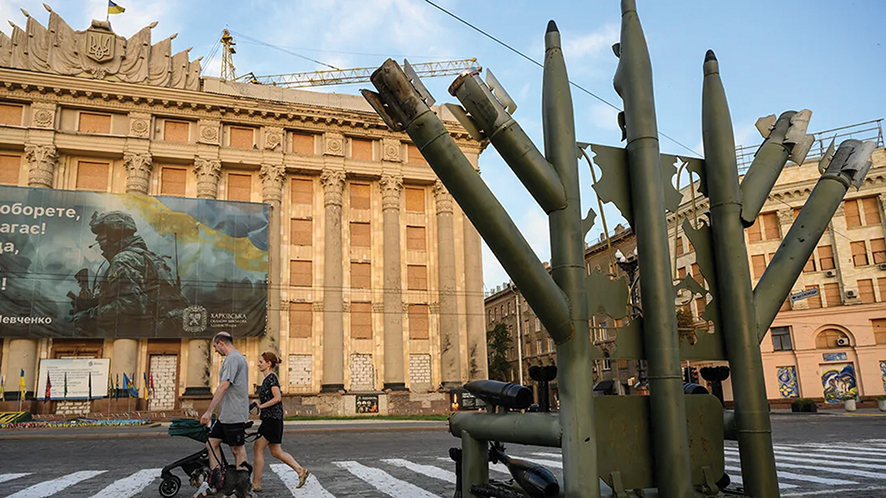The war in Ukraine has entered yet another tense chapter, with developments on both the battlefield and in international diplomacy underscoring the conflict’s growing complexity. In Washington, President Donald Trump’s administration has signaled an unprecedented willingness to allow Ukraine to conduct long-range strikes deep into Russian territory, while in Europe, leaders are stepping up military support in an effort to prevent Kyiv from losing further ground. Meanwhile, Moscow has intensified its own attacks and launched its largest conscription drive in nearly a decade, reinforcing Vladimir Putin’s message that Russia is committed to what he calls a “righteous battle.”
This week, retired General Keith Kellogg, the US Special Envoy for Ukraine, confirmed that Trump has authorized Kyiv to use American-supplied weapons for deep strikes inside Russia. Speaking to Fox News, Kellogg was unequivocal: “If we read what he has said, and also what Vice President Vance and Secretary Rubio have said, the answer is yes.
Use the ability to hit deep. There are no such things as sanctuaries.” He recalled that Ukrainian President Volodymyr Zelensky had personally asked Trump for cruise missiles with ranges of up to 2,500 kilometers during their recent meeting, although no final decision has been made on supplying Tomahawk missiles.
The prospect of Kyiv gaining the ability to hit strategic Russian sites far from the frontlines has provoked alarm in Moscow, where officials warn that such moves would represent direct American involvement in the war. Kremlin figures have hinted that US personnel could become targets if they are found to be assisting with targeting or launch operations. Analysts note that authorizing Tomahawks would mark a significant escalation, far beyond the use of shorter-range ATACMS missiles, which Washington only permitted against Russian territory in late 2024. The internal debate within the US administration reflects a broader divide between Trump’s aggressive stance and Pentagon caution, with reports suggesting that Defense Secretary Pete Hegseth has frequently blocked Ukrainian attempts to expand long-range operations despite presidential approval.
On the battlefield, Russia has continued to press its advantage, capturing the Donetsk settlement of Sieversk Malyi and expanding control over the nearby villages of Shandryholove and Zarichne. Video released by Russia’s defense ministry showed troops raising their flag as they advanced through residential areas, underscoring Moscow’s determination to inch westward in the Donbas. These gains come as Ukrainian officials acknowledge mounting losses. As reported by the General Staff in Kyiv, Russian combat deaths have now surpassed 1.1 million since the start of the war, with nearly a thousand soldiers reported killed in the past 24 hours alone.
The toll on civilians also remains devastating. In Ukraine’s northern Sumy region, a Russian drone strike destroyed a family home in the village of Chernechchyna, killing a couple and their two young sons. Regional governor Oleh Hryhorov described the deaths as “a terrible and irreparable loss,” while officials in Kyiv reiterated calls for stronger Western air defense support.
For Moscow, the war is both military and ideological. In a speech marking the third anniversary of Russia’s annexation of Donetsk, Kherson, Luhansk, and Zaporizhzhia regions, President Putin vowed to prevail.
“Together we are defending our love for the motherland and the unity of our historical destiny,” he said, portraying the conflict as an existential struggle against Ukraine and its “Satanic” Western allies. At the same time, the Kremlin launched its largest autumn conscription since 2016, drafting 135,000 men. Officially, conscripts are not supposed to be sent into combat, yet previous admissions of “mistaken deployments” raise questions about whether the new recruits will eventually find themselves on the frontlines. Putin has ordered the military to expand to 1.5 million active personnel by 2026, signaling his long-term preparation for confrontation with the West.

Across the Atlantic, Trump has sharpened his rhetoric as well. In a recent social media post, he likened Ukraine’s predicament to a sports team forbidden from attacking. “It is very hard to win a war if you are not allowed to strike the invader’s country,” he wrote, blaming his predecessor Joe Biden for “tying Kyiv’s hands.” Trump insists that the war would never have started under his leadership and maintains that Ukraine can not only reclaim occupied territory but potentially push even deeper if given the right tools.
European leaders are also intensifying their support. In Brussels, European Commission President Ursula von der Leyen announced an agreement with Ukraine to allocate €2 billion for drones, hailing the technology as central to Ukraine’s defense and Europe’s own security. “This allows Ukraine to scale up and use its full capacity,” she said alongside NATO Secretary General Mark Rutte. The EU sees drones not only as weapons for Ukraine but also as a foundation for building what it calls a “drone wall” along its eastern border, intended to counter Russian incursions. This initiative follows earlier announcements of €6 billion in EU funds, drawn from profits on frozen Russian assets, earmarked for drone production.
Despite these developments, there is little progress on diplomacy. The Kremlin has said it is no longer in contact with Kyiv over possible peace talks, and spokesman Dmitry Peskov confirmed there are no plans to revive negotiations. Russian and Ukrainian negotiators last met in July, but prospects for dialogue appear remote. Kellogg, speaking at the Warsaw Security Forum this week, admitted to a “level of frustration” over the lack of talks, though he insisted that Russia is not winning the war and that Ukraine has fought “boldly and exceptionally well.” Still, he acknowledged the uncertainty surrounding Putin’s intentions, saying, “No one in this room can figure out what Vladimir Putin is thinking.” He added that while he remains an optimist, the Russian leader may already recognize “in his heart of hearts” that he cannot ultimately win.
A wave of Ukrainian drone attacks on Russian oil refineries has sparked a fuel market crisis, forcing Moscow to impose export bans and prepare for emergency imports. Based on the data from the Siala news agency, cited by Russia’s RBC, more than twenty major refineries have come under attack since early August. The strikes have cut Russia’s refining capacity by 38%, equivalent to around 338,000 tons per day. Russian media report that capacity for gasoline and diesel production dropped by 6% in August and a further 18% in September, calling the scale of the disruption historically unprecedented. By late September, about a quarter of Russia’s oil refining capacity was offline, with Siala attributing roughly 70% of the outages to drone strikes. Four refineries were forced to halt production last month alone, including “Kinef” in the Leningrad region—the country’s second-largest plant—and Rosneft’s Ryazan facility, one of Russia’s top five. The disruption has translated into acute fuel shortages at home. Business daily Kommersant reported that in September, shortages reached 20% of domestic consumption, hitting Crimea and the Far East hardest. In some regions, authorities introduced restrictions, banning the sale of more than 30 liters of gasoline per person. Shortages have now been recorded in over 20 regions across the country. Economists quoted by Russian outlets warn that oil companies are largely powerless to resolve the crisis quickly, since repairs at damaged facilities could take months—especially under the weight of Western sanctions, which restrict access to vital equipment and technology. In response, the Russian government has banned gasoline exports and moved to secure supplies abroad. To facilitate imports, the Eurasian Economic Union has lifted duties on gasoline, diesel, and jet fuel.
Compiled by Ana Dumbadze














